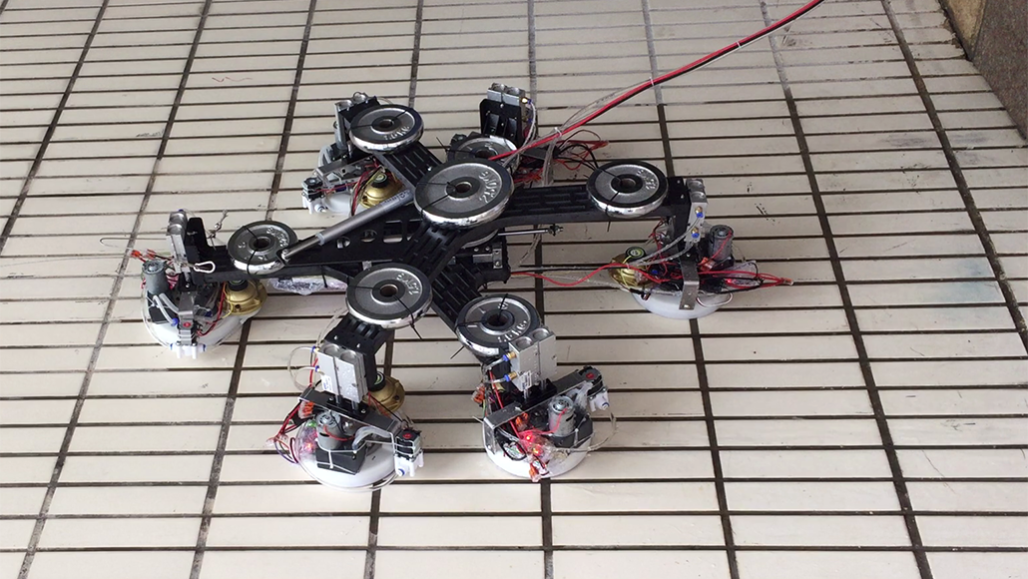Climb like a slo-mo Spiderman using this super suction robot
A whooshing ring of water keeps the robot’s vacuum from losing grip, even on rough surfaces

This robot has suction devices attached to each of its six arms. A ring of quickly moving water in each suction device allows this bot to climb up walls.
Xin Li and Kaige Shi
A new robot helps people scale walls like a slow-motion Spiderman. It can even ascend bumpy surfaces on which other climbing bots struggle to stick. Its trick? Whooshing rings of water power that super suction.
Researchers described how they make it work in the January issue of Physics of Fluids.
“They’ve gone out and reinvented the suction cup.” says Pauline Pounds. She works at the University of Queensland in Brisbane, Australia. The robot’s suction system “is something really different,” observes this roboticist, who was not involved with this project.
Such climbing robots could someday clean or do repairs in high places. “There are many jobs where you need to get up high, but a drone cannot fit or wouldn’t be able to carry enough weight,” Pounds explains.
Suction devices stick to things by changing the air pressure inside of them. For example, when you’re sucking dust up with a vacuum’s hose, it might stick to the carpet. Inside the vacuum cleaner, a fan spins, pushing air out of the device. That reduces the air pressure inside the device so that it’s lower than the pressure outside. This low pressure is called a “vacuum.” Air from the outside rushes in to fill that vacuum. That’s what creates the suction.
In a suction cup, squashing the cup against a wall pushes air out. That creates an area of low pressure inside the cup, causing it to stick.
Suction cups work best on smooth surfaces, such as glass and smooth shower tiles. To make a normal suction cup or vacuum device cling to a bumpy surface, someone might use a squishy seal — one that can deform around bumps to close up gaps. This should cut off a path for air to enter and break the vacuum. But that all important air seal may not develop, especially on rough surfaces.
Mechanical engineer Xin Li came up with the idea for the new robot. He works at Zhejiang University in Hangzhou, China. The flow of swirling liquids — such as hot cocoa when it’s stirred — inspired him. The rotating flow maintains a shape where the center looks sunken as the fluid gets pushed to the outer edge. Li thought he could apply this concept to create suction.
The researchers came up with a six-armed robot. Each arm is equipped with a suction device that sticks because of water. In each suction device, a fan spins inside a chamber filled with air and water. The force created by the spinning fan pushes the denser of the two fluids, water, to the outside (both air and water are fluids). Then a little pump sucks out the air left in the center.
The swirling water changes the pressure at the edge of the chamber, explains Pounds, in Brisbane. When the water is being flung out, it puts pressure on the chamber walls. The void left in the center becomes an area of lower pressure. A small pump provides suction at the center. The swirling water helps to maintain the suction, Pounds observes.
This suction is tough to break, even on rough surfaces. Like in a straw or the nozzle of a vacuum cleaner, air flows from high pressure to low pressure. But in this system, the whooshing water is at the same pressure as the outside air. That means there’s no difference in pressure to pull air in from outside.
Water seal
Li and his colleague Kaige Shi made suction devices in several sizes. These ranged from 130 millimeters across (about 5 inches) to 280 millimeters. The researchers put these gadgets to work in a few ways.
They attached one to a robotic arm and used it to pick up a block of concrete. With six suction units, they made a robot that could scuttle up a tiled wall. They also used a pair of the biggest units to carry Shi, a grown man weighing 67.5 kilograms (149 pounds), up the side of a building.
Shi grasped a suction robot in each hand and put each of his feet into loops that dangle from the bot. When the robots move, he looked like he was scaling a wall.
Especially on rough surfaces, “the robot climbs very slowly,” Li notes. That’s because it’s easier to get the water ring going on smooth surfaces than on rough ones.
The prototype robot uses water that’s drawn in through a tube. It uses quite a bit of water. But if the researchers can cut down how much is needed, this robot should be able to bring the water it needs to climb.
The prototype robot uses a small pump to get its vacuum going. It weighs less — and uses less power — than a typical system that creates suction. That means “it can carry more cameras or sensors or batteries to go about doing its mission,” notes Pounds, in Brisbane.
Instead of just improving existing suction methods, Shi and Li came up with a new approach. That provides a lesson for all would-be innovators, Pounds points out. “Do something radically different and you’ll be surprised.” Even if it doesn’t work,” she says, “you’ll learn something.”